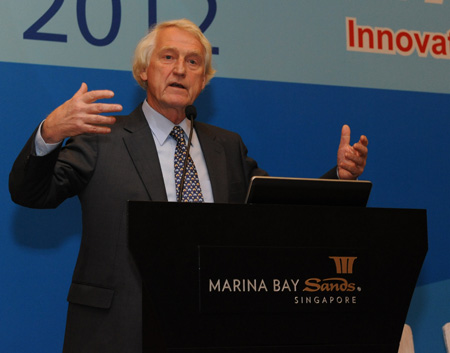
(Picture Credit: EMA)
Sustainable energy throws up an abundance of challenges. Professor Joachim Luther, nuclear physicist and Scientific Information Manager at Solar Energy Research Institute of Singapore (SERIS), sought to tackle many of the most pressing questions in a forum at the PVAP Expo & conference during SIEW 2012.
Prof Luther highlighted the protection of natural life, reduction of energy poverty in developing countries, increased energy security, reduced volatility in the cost of energy supply, and promotion of peace through a reduction in the dependence on regionally-concentrated energy sources as among some of the clearest benefits of developing sustainable energy systems.
He reminded audiences that renewable sources of energy, while present in abundance, presents many challenges in developing them. The key issues are which of the renewable sources should we invest in?
He said that the sustainability potential of solar energy is 10,000EJ/year, while wind energy is > 1,000EJ/ year--making both the highest among all renewable sources and therefore the most attractive choices.
He pointed out that investing in these sources for future development is expensive at present because of the capital investment, but that cost per year will come down in the future once the capital-intensive part of setting up solar panels and wind farms to replace coal and gas plants is completed.
Another challenge to attain sustainability using solar and wind energy is to deal with the seasonal fluctuations, ie in winter and the rainy season there is hardly any sun, while wind is too often seasonal in nature. This challenge could be overcome by establishing smart grids. Smart grids would:
- Match demand and generation on local and central levels
- Control the energy demand through variable tariffs
- Control of renewable and conventional electricity generation
- Forecast energy weather for solar and wind energy
- Store energy in batteries, hydro and similar resources
- Establish large areas of intercontinental grids to control and stabilise seasonal fluctuations
Prof Luther said storage is another key challenge in attaining sustainability. Energy systems would have to be carefully designed so energy is not wasted and the cost of storing energy is optimised. Energy storage solutions could be applied residentially as well, which would help lower volatility of energy demand at the grid level.
Currently, energy grids are being established in Africa and Europe. Prof Luther said this kind of intercontinental grid structure would stabilise demand and supply across these continents. He warned that the operational completion of this project depends on the political situation in North Africa and economic situation in Europe--which present two more major challenges in making solar and wind energy sustainable, at least in the short term.
One of the solutions offered is to lay an undersea cable to fulfill the needs of countries including Singapore, Malaysia and Indonesia. And while the capital investment required would be very high, the variable cost of transferring energy would be comparatively small. Prof Luther advised leaders in the region to focus on viable solutions to establish either intercontinental or intra-continental grids.
By :Naveen Malik, EMA